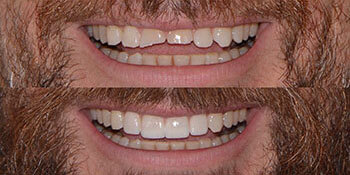Dental Bonding Toronto
What Is Dental Bonding?
Composite bonding, also known as bonding, is a cosmetic dental procedure that can repair and enhance the appearance of teeth. Using materials that match the shade, translucency, and texture of the patient's existing teeth, gaps between teeth can be closed, spots and discolorations can be eliminated, and overall self-confidence can be increased through the improved appearance of the smile.
What's Involved in Dental Bonding
Our dentists will match the shade of the patient's existing teeth and then apply tooth-coloured composite resin to the tooth, similar to the procedure used for fillings. The resin is then hardened with a curing light and shaped, contoured, and polished to give an authentically natural appearance.
A Rapid Fix for Minor Dental Concerns
Composite bonding is excellent for small defects in the teeth such as:
- Worn out teeth
- Chipped teeth
- Teeth with gaps
Comparing Dental Bonding to Other Dental Treatment Options
When it comes to restoring your teeth or achieving your dream smile, there are various options available. The best choice for you will depend on your specific needs. During your consultation, we will discuss all of your options and the benefits and drawbacks of each, to help you make an informed decision. One option to consider is dental bonding, which has several advantages, such as:
- Being quick and painless: Unlike fillings or dental veneers, which require some drilling to prepare the tooth, dental bonding usually does not require any removal of your natural tooth, making it almost always completely painless.
- Being a cost-effective option: More extensive treatments like dental veneers and orthodontics can be more expensive. However, for minor changes to a few teeth, dental bonding is a simple and cost-effective treatment.
- Being great for small repairs: If you're envisioning extensive changes to your smile, you may benefit from a more complex treatment plan like dental veneers, crowns, or orthodontics. But for minor changes, dental bonding is a simple solution.
How long does dental bonding last on front teeth?
Dental bonding typically lasts for three to 10 years before requiring a touch up. It is generally recommended for teeth that don’t have as much biting force since dental bonding results aren’t as long lasting as other procedures. If you apply dental bonding to your front teeth, the results may not last as long.
Is dental bonding permanent?
Like many dental procedures, the results of dental bonding treatment aren’t permanent. You can expect to book a touch up appointment around three to 10 years after your first appointment.
The time frame can vary based on individual patients, their lifestyle, and their oral hygiene habits. The better you take care of your teeth and are careful with what you eat, the longer your results will last. While dental bonding isn’t a permanent treatment, it’s a great long-lasting solution for minor imperfections like chipped teeth, small gaps, and discoloration.
What is better, bonding or veneers?
This depends on your situation. Many dentists typically recommend dental bonding for minor imperfections because they are a cheaper way to target issues like gaps and discoloration. Your dentist will use resin that matches the color and texture of your teeth.
Dental veneers are more expensive, but the results are more long-lasting than dental bonding. If you’re concerned about issues like teeth stains and discoloration, it’s best to have dental veneers because the materials are stain resistant. Bonding will eventually darken over time. Veneers are especially great for stains that can’t be targeted with teeth whitening treatments.
However, for chipped teeth and or gaps between your teeth, dental bonding may be a better option. Bonding can also be used to fill cavities, while veneers are not as often used. Regardless of what option you choose, it’s best to consult with a professional to consider if you’re a suitable candidate and if the treatment gives you the results you want.
How does cosmetic bonding work?
Cosmetic bonding uses resin to coat the surface of your tooth. Your dentist will first roughen the surface of your tooth before applying a liquid that allows the bonding agent to stick. They’ll choose a resin composite that matches the color, translucency, and texture of your teeth. The resin is polished and shaped after it hardens to give you the desired look you want.

